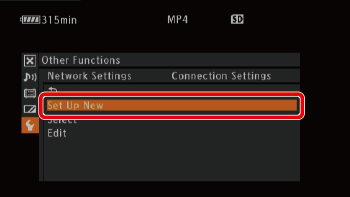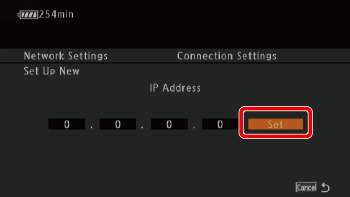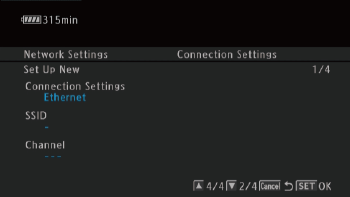Solusi
You can use the Playback via Browser function to access the MP4 clips and photos in the camcorder from the Web browser of a connected computer or other devicve. You can then play back your recordings using the Web browser and even save local copies of them on the device.

Step 1: Performing Camcorder Settings

Step 2: Connecting the Computer or other Device and Playing back/Saving Recordings

Step 3: Ending Playback via Browser Mode
NOTE
- The following example shows the procedure when performed in Windows 7 using Internet Explorer 9.
- Only one device may be connected to the camcorder at a time.
- Long recordings, whose video stream file exceeds 4 GB, will be recognized as multiple files on other devices.
IMPORTANT
- The instructions in this chapter assume you already have a correctly configured and working network, and network device(s). If necessary, refer to the documentation provided with the network devices you want to use.
- Configuring the network settings requires adequate knowledge about configuring and using wired (Ethernet) and/or wireless (Wi-Fi) networks. Canon cannot provide support regarding network configurations.
CAUTION
- Canon shall not be liable for any loss of data or damage resulting from incorrect network configuration or settings. Additionally, Canon shall not be liable for any loss or damage caused by the use of network functions.
- Note that using an unprotected Wi-Fi network can expose your data to monitoring by unauthorized third parties. Be aware of the risks involved.
Step 1: Performing Camcorder Settings
1. Hold down the button on the <POWER> switch and slide the switch to <MEDIA>.
2. Press the <INDEX> button and Open the [MP4] or [Photos] index screen.
3. Connect the camcorder to a router or other device connected to a wired (Ethernet) network using a commercially available LAN cable.

: LAN access indicator

: LAN terminal

: LAN cable (commercially available)

: LAN port on a network device
NOTE
Use Category 5e, shielded twisted pair (STP) LAN cables compatible with Gigabit Ethernet (1000BASE-T) with good shielding capability.
4. Press the <MENU> button.
5. Push the joystick up/down to select [

Other Functions] -> [Network Settings] -> [Connection Settings], and then press <SET>. Then, Select [Set Up New], and then press <SET>.

: Joystick

: In the following procedures, 'Press <SET>' refers to the action of pressing the joystick straight down to select the desired setting.
6. Select [Ethernet] and then press <SET>.
7. Select the method for assigning the IP address and then press <SET>.
- [Automatic]: IP settings will be assigned automatically. Please proceed to step 13.
- [Manual]: The IP address, Subnet Mask, and Default Gateway must be entered in manually. Please continue to step 8 for [Manual] setting procedures.
The steps for performing [Manual] settings are explained below.
8. Enter the IP address, Subnet Mask, and Default Gateway.
Push the joystick up/down to select a value for the first field and then press <SET>.
The cursor will move to the next field.
Repeat the process for all four fields.
9. Select [Set] on the right side of the screen, and then press <SET> to confirm the address.
10. Enter the [Subnet Mask] and [Default Gateway] addresses in the same way.
11. Select the desired method for setting up the DNS server, and then press <SET>.
- [Do not use DNS]: A DNS server will not be used.
- [Manual]: The [Primary DNS Server] and [Secondary DNS Server] must be entered manually.
The steps for performing [Manual] settings are explained below.
12. Enter the [Primary DNS Server] and [Secondary DNS Server] using the process explained above for entering the IP address.
13. Confirm the settings.
Push the joystick up/down to review additional settings before pressing <SET>.
14. Save the settings.
Push the joystick up/down to select the desired configuration number and then press <SET>.
15. If necessary, enter the [Network Configuration Name].
Select [Input] and then press <SET>.
Enter the network configuration name.
Select [OK] and then press <SET>.
REFERENCE
Using the Virtual Keyboard Screen
Use the joystick to select a character and then press <SET> to add it.
Use the arrows ( [

] / [

] / [

] / [

]) to change the position of the cursor and the backspace character [

] to delete the last character entered.
After entering the desired text, select [OK] and then press <SET> to close the keyboard screen.
16. Select [OK] and then press <SET>.
You can save up to 5 different network configuration profiles in the camcorder. If you select a configuration number that was already in use, the previous configuration will be overwritten by the new one.
18. Press the [CANCEL] button twice to return to the menu before the previous menu ( [

Other functions]).
19. Select [

Other Functions] > [Playback via Browser] and press <SET>.
[Connected] and the camcorder’s URL will appear on the camcorder's screen.
While the camcorder is in Playback via Browser mode, only the <POWER> switch, CANCEL button and the joystick’s SET button can be used on the camcorder.
NOTE
Pressing <SET> while the screen shown in the example image below is displayed will end Playback via Browser mode.
Step 2: Connecting the Computer or other Device and Playing back/Saving Recordings
1. Start the network device’s Web browser.
2. Enter the URL displayed on the camcorder’s screen.
The Playback via Browser screen will appear.
3. Select the desired MP4 movie or photo to play it back.
To change the index screen displayed, click the button on the top left of the screen:
4. Click [

] or [

].
5. Click the desired recording from the list of recordings.
6. For MP4 movies, click [

] to begin playback.
Photos will be displayed after they are clicked.
7. Click [

] to return to the list of recordings.
8. To save to a network device (other than iOS devices) click [

] to save a local copy of the MP4 clip/photo on the device.
Step 3: Ending Playback via Browser Mode
1. When you have finished playing back, press <SET> to end the Playback via Browser mode.
Playback via Browser mode will end.
- Wi-Fi is a registered trademark of the Wi-Fi Alliance.
- Wi-Fi Certified, WPA, WPA2, and the Wi-Fi Certified logo are trademarks of the Wi-Fi Alliance.
 Step 1: Performing Camcorder Settings
Step 1: Performing Camcorder Settings  Step 2: Connecting the Computer or other Device and Playing back/Saving Recordings
Step 2: Connecting the Computer or other Device and Playing back/Saving Recordings Step 3: Ending Playback via Browser Mode
Step 3: Ending Playback via Browser Mode





 : LAN access indicator
: LAN access indicator : LAN terminal
: LAN terminal : LAN cable (commercially available)
: LAN cable (commercially available) : LAN port on a network device
: LAN port on a network device
 Other Functions] -> [Network Settings] -> [Connection Settings], and then press <SET>. Then, Select [Set Up New], and then press <SET>.
Other Functions] -> [Network Settings] -> [Connection Settings], and then press <SET>. Then, Select [Set Up New], and then press <SET>.
 : Joystick
: Joystick : In the following procedures, 'Press <SET>' refers to the action of pressing the joystick straight down to select the desired setting.
: In the following procedures, 'Press <SET>' refers to the action of pressing the joystick straight down to select the desired setting.











 ] / [
] / [  ] / [
] / [  ] / [
] / [  ]) to change the position of the cursor and the backspace character [
]) to change the position of the cursor and the backspace character [  ] to delete the last character entered.
] to delete the last character entered.


 Other functions]).
Other functions]).

 Other Functions] > [Playback via Browser] and press <SET>.
Other Functions] > [Playback via Browser] and press <SET>.






 ] to show MP4 clips or [
] to show MP4 clips or [ 

 ] to show photos.
] to show photos.
 ] or [
] or [  ].
].

 ] to begin playback.
] to begin playback.
 ] to return to the list of recordings.
] to return to the list of recordings. ] to save a local copy of the MP4 clip/photo on the device.
] to save a local copy of the MP4 clip/photo on the device.

